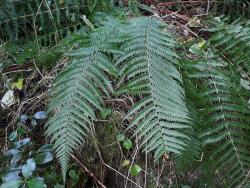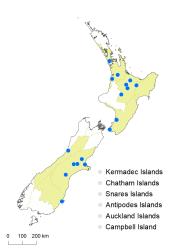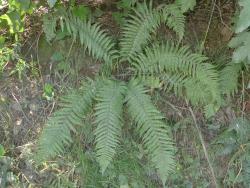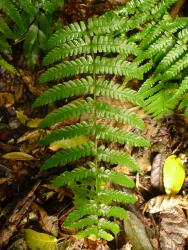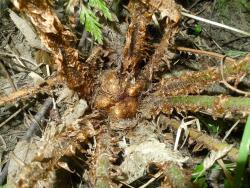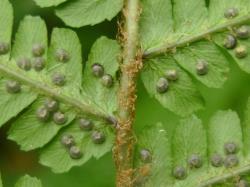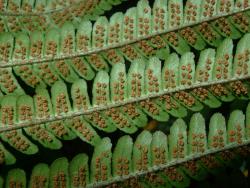- Taxon
- Gallery
- ≡ Nephrodium affine Lowe, Trans. Cambridge Philos. Soc. 6: 525 (1838)
Rhizomes erect, densely scaly. Rhizome scales ovate, 12–15 mm long, 2–5 mm wide, golden brown, concolorous, margins entire. Fronds 550–1290 mm long. Stipes 110–450 mm long, pale brown, densely scaly throughout; scales ovate or narrowly ovate, golden brown, up to 18 mm long and 4 mm wide. Rachises pale brown, sulcate, narrowly winged distally, scaly; scales abundant throughout, narrowly ovate, golden brown, up to 10 mm long and 1.5 mm wide. Laminae 2-pinnate at base, elliptic or narrowly elliptic, 410–910 mm long, 140–270 mm wide, mid- to yellow-green on both surfaces, herbaceous, bearing flat scales on both costa surfaces and the abaxial lamina surface. Primary pinnae in 27–46 pairs below pinnatifid apex, widely spaced throughout, narrowly ovate or narrowly triangular; the longest at or near the middle, 75–150 mm long, 18–30 mm wide, apices acuminate, bases stalked; costae narrowly winged throughout; dark patches at costa/rachis junction when fresh. Secondary pinnae decreasing very gradually in length along the primary pinna to the distal end; the longest secondary pinnae oblong, 9–18 mm long, 3–7 mm wide, apices rounded or truncate, margins entire or toothed near apices, bases adnate. Sori on distal primary pinnae only, round, in 1 row either side of costa, nearer costa than margin; indusia reniform, rolled under sori when young, 0.8–1.2 mm diameter, concolorous, glabrous.
Dryopteris affinis is recognised by its erect rhizomes, golden brown scales, densely scaly stipes and rachises, 2-pinnate laminae, secondary pinnae of uniform size, basal basiscopic secondary pinnae on the lowermost pair of primary pinnae not extended, and sori confined to the distal half of the lamina. It is very similar to D. filix-mas but differs in that the stipe is more abundantly covered in scales that are golden brown rather than pale brown, and in having more widely spaced and slightly narrower primary pinnae (18–25 mm wide, cf. 17–38 mm wide), more widely spaced secondary pinnae with truncate rather than rounded apices, and indusia that are inrolled when young rather than flat. In living plants there are dark patches abaxially at the costa/rachis junctions.
Cultivars with crested pinna apices occur occasionally in the wild (e.g. CHR 461167, Coalgate, Canterbury) and are referable to ‘Cristata’, sometimes known as ‘Cristata the King’ (Hoshizaki & Moran 2001).
North Island: Auckland, Volcanic Plateau, Gisborne, Southern North Island.
South Island: Canterbury, Westland, Otago.
Altitudinal range: 0–650 m.
Dryopteris affinis occurs in scattered lowland and montane localities from Auckland to Dunedin. It ranges from near sea level, up to 650 m near Lake Rotoaira in the central North Island.
Occurs naturally in Europe, Asia and North Africa (Tutin et al. 1964; Roux 2009).
Dryopteris affinis grows under mānuka and kānuka scrub, beech forest, and introduced willows, pine and Douglas fir plantations, often on road banks, river terraces, in damp valleys, or at the base of clay banks. It also occurs as a spontaneous garden weed.
Lovis (1980). Voucher WELT P023121, 1963.
Dryopteris ×tavelii Rothm., the hybrid between D. affinis and D. filix-mas, has been recorded from the Rakaia Gorge, Canterbury (WELT P023374–023378) and from Dunedin (WELT P011737–011738).
No chromosome count has been reported for New Zealand plants. In Europe, diploid and triploid apomictics are known (Fraser-Jenkins 1980).
The names Dryopteris borreri Newman and D. pseudomas (Wollaston) Holub & Pouzar have previously been used on New Zealand herbarium specimens for this taxonomically and nomenclaturally difficult complex (Fraser-Jenkins 1980).



